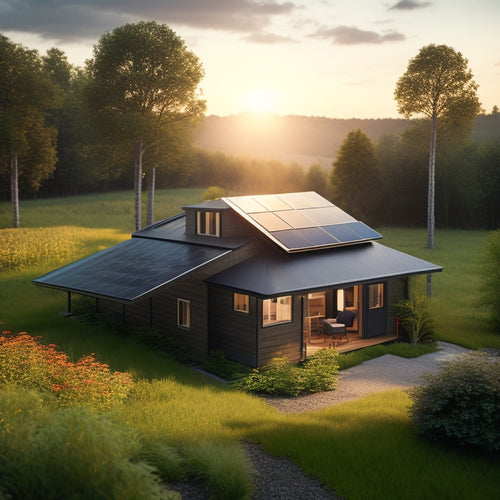
Why Choose Emergency Backup Inverters Wisely
Share
When choosing an emergency backup inverter, you're selecting a vital component that guarantees uninterrupted power supply to your essential systems. You need an inverter that seamlessly integrates with your existing infrastructure, handles power surges and spikes, and provides high-quality power output. With so many options available, it's essential to prioritize efficiency, compatibility, and power quality. By understanding your specific needs and considering key features, you'll be able to make an informed decision. Now, take the next step in designing a reliable emergency backup system that meets your unique requirements.
Overview
- High inverter efficiency ensures minimal energy losses, reducing battery drain and increasing backup duration during power outages.
- Compatibility with preferred battery technology and seamless integration of components are crucial for reliable emergency backup operation.
- Selecting the right inverter type (modified sine wave, pure sine wave, grid-tie) and power quality features ensures stable output voltage and frequency.
- Correct sizing of the inverter and battery capacity is essential to handle required loads, prevent overload, and ensure reliable operation during outages.
- Advanced features like real-time monitoring, surge mitigation, and proprietary communication protocols enhance the effectiveness and reliability of the emergency backup system.
Understanding Emergency Power Needs
When you're responsible for critical infrastructure, process control, or life-safety systems, you understand that power outages can have disastrous consequences. You need a reliable backup plan to guarantee continuous operation and maintain energy efficiency.
Emergency power systems are designed to kick in during outages, providing a seamless shift from grid power to backup power. The importance of energy independence and minimizing reliance on fossil fuels can't be overstated.
Additionally, evaluating systems for compatibility with existing setups, capacity, and depth of discharge is essential for achieving grid resilience. To determine your emergency power needs, you must identify the critical loads that require backup power, calculate the required power rating, and consider the duration of the backup power supply.
Key Features to Look For
You've specified your emergency power needs, now it's time to focus on the emergency backup inverter itself. When selecting an inverter, consider the following key features:
| Feature | Description |
|---|---|
| Inverter Efficiency | Look for high efficiency ratings (e.g., 95% or higher) to minimize energy losses and reduce battery drain. |
| Battery Technology | Choose an inverter compatible with your preferred battery technology (e.g., lead-acid, lithium-ion). |
| Power Surge Capability | Make sure the inverter can handle power surges and spikes, protecting your equipment from damage. |
These features will help you find an inverter that meets your power needs and provides reliable backup power during outages. By prioritizing inverter efficiency and compatibility with your battery technology, you'll get the most out of your emergency backup system.
Inverter Compatibility and Integration
Your emergency backup system's reliability hinges on the seamless integration of its components. When selecting an inverter, make certain it's compatible with your existing system.
You'll want to take into account the type of inverter you need - modified sine wave, pure sine wave, or grid-tie - and the specific brand that integrates well with your setup. Different inverter brands often have proprietary communication protocols, making it vital to choose an inverter that's compatible with your system's monitoring and control infrastructure.
For instance, if you have a Schneider Electric system, you may want to opt for an inverter from the same brand to guarantee seamless communication. Additionally, it's important to verify the inverter's DC input requirements align with the solar panel voltage range voltage requirements and take into account flexible string configurations to customize voltage outputs as needed.
Compatibility issues can lead to system downtime, so it's important to get this right.
Power Quality and Surge Protection
Selecting an inverter that guarantees high power quality and adequate surge protection is vital to safeguarding your emergency backup system from damage and downtime.
You want an inverter that secures power stability, which means it can maintain a consistent output voltage and frequency, even when the grid is unstable. This is essential for sensitive equipment that requires a stable power supply.
Furthermore, advanced inverter technology with real-time monitoring and control capabilities can help optimize energy harvesting and reduce downtime.
Additionally, your inverter should have built-in surge mitigation capabilities to protect your system from power surges and spikes. This feature will prevent damage to your equipment and minimize the risk of downtime.
Sizing and Installation Considerations
When configuring an emergency backup system, sizing the inverter correctly is essential to confirm it can handle the required load.
You'll need to calculate the total power requirement of your appliances and devices, taking into consideration their wattage, surge capacity, and usage patterns.
Verify the inverter's continuous power rating exceeds this total load to prevent overload and system failure.
Additionally, consider the battery capacity, as it must be able to supply power to the inverter during an outage.
The installation location is also vital, as it affects the inverter's operating temperature and overall performance.
You should install the inverter in a well-ventilated area, away from moisture and extreme temperatures, to guarantee reliable operation during emergency situations.
Frequently Asked Questions
Can I Use an Emergency Backup Inverter for Off-Grid Systems?
You can use an emergency backup inverter for off-grid systems, leveraging off-grid advantages like independence from the grid, but make certain you select an inverter with sufficient capacity to meet your power needs during extended outages or critical situations.
Do Backup Inverters Require Regular Maintenance Checks?
You're like a sailor steering through treacherous waters without a compass if you neglect regular maintenance checks on your backup inverter, which can reduce its lifespan; aim for frequency checks every 6-12 months to guarantee smooth sailing.
Are There Specific Certifications for Emergency Backup Inverters?
You need to look for emergency backup inverters with certifications from reputable organizations, such as UL or ETL, which verify the products meet strict certification standards, and check the inverter ratings to confirm reliable performance during power outages.
Can I Install an Emergency Backup Inverter Myself?
You can install an emergency backup inverter yourself, but you'll need to follow strict installation guidelines and take necessary safety precautions to avoid electrical shocks, fires, or system damage, ensuring a reliable and safe backup power supply.
Are Emergency Backup Inverters Compatible With Renewable Energy Sources?
You're not limited to fossil fuels; you can utilize the power of nature! Emergency backup inverters are incredibly compatible with renewable energy sources, ensuring seamless inverter compatibility and renewable integration for an uninterrupted, eco-friendly power supply.
Ready to Buy
When selecting an emergency backup inverter, it's essential to prioritize your specific power needs and consider key features, compatibility, and installation requirements. According to the US Energy Information Administration, in 2020, the average American experienced over 1.5 hours of power interruptions per year. By making an informed decision, you can guarantee a reliable and efficient backup power system that keeps your critical loads running smoothly during outages.
Related Posts
-

Smart Home Thermostats to Revolutionize Your Space
Smart home thermostats revolutionize your space by providing precise temperature control and optimizing energy saving...
-

Diy Off Grid Solar
By embracing DIY off-grid solar, you can break free from grid dependence, slashing your energy bills by up to 90% and...
-

Top Camping Water Bottles for Adventure
When you're out adventuring, picking the right camping water bottle is essential for staying hydrated. Look for durab...


